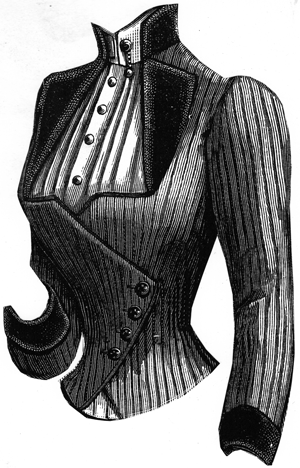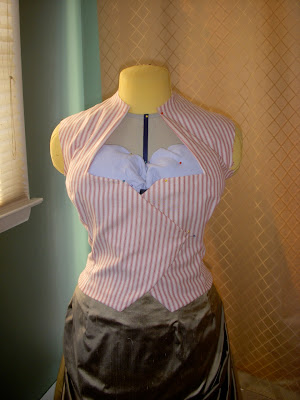I am impatient. I told myself I was going to make a third muslin to test the last round of pattern adjustments, but then Idecided I was confident enough to move forward without it. I really want to wear this outfit this weekend at my DH's birthday party.
I hemmed and hawed over how to match the stripes. My fashion fabric has uneven stripes and I've never had to match stripes before. (Of course it has uneven stripes! Why would I start simple and work towards more complex projects?) I consulted references. I played with layout. Finally, I cut and put the bodice together.
Stripes
>
I'm not unhappy with these results, but I clearly did not understand which elements of the striping would have the most visual impact.
- I should have focused more on the horizontal seams rather than the vertical seams for this piece because (I think) of the extreme curves at the waist. There's no real way to match those and I would have gotten a lot out of matching stripes at the back shoulder.
- Maybe it would have been better to keep the diagonal stripes in the side back to distract from the fact that the back and the side front (also visible on the back) are going to require different grain lines.
- The front overlaps do mirror each other, but perhaps I would have made a stronger impact with this uneven stripe if I have matched the stripes. I suspect that this would have meant giving up matching the shoulder seam stripes, but it could have been another option.
Again, I'm not upset about the results, I just learned some lessons about stripes.
Fit
The neck and shoulder slope of my dress form is slightly different from my own and I'm not sure there's a way to fix that short of re-carving the foam core. Most of the time, this doesn't get in my way, but for tightly fitted garments, it starts to show. I tried the shell on and the fit at the back of the neck is much better on me, even though it looks worse on the dress form.
Facing/Lining
I decided that I didn't want to do a full lining for this piece.
- It's a costume piece, so I should go for show over full tailoring.
- Costumes are usually worn in spring or summer and can get really hot -- this bodice is already worn with a corset and two silk skirts. I will probably not catch my death of cold.
- The pattern gives no explicit directions for inserting the lining. I've already had to make up so much of the construction details and I didn't want to complicate the process by trying to figure out when I should attach pieces of the lining.
However, a front facing seemed to be a good idea. It gives me something to anchor the vest piece to without risking visible stitches and it creates a nice finished look for any of the openings that might get casually exposed.
I faked up a lining pattern like this:
Revers/Lapels (wretched, wretched lapels)
I was just about to sew the facing to the top shoulder seam, when I remembered something: I had lapels and a collar to add. I would probably want the lining to go over those. I should add that it's hard to see from the bodice shell, but I hadn't sewn the shoulder seams yet. I wanted the facing to be securely anchored a the shoulder and not just hand sewn in later.
The lapels are ridiculous. They don't fold over from the main bodice like a modern suit jacket because they are "interrupted" by the neck line. I'm not describing this very well. Here's the design image again:
The lapel piece extends far beyond the opening, so it took a great deal of fiddling before I could get them to look reasonable. Here's the construction approach I finally chose. By the way, the instructions that came with the pattern said "attach revers and collar". Thanks.
Step 1) With lapel point toward center, sew right side of lapel to wrong side of fabric. This means that the bodice seam allowance will not be finished, rather just hidden by the lapel when it is folded to the right side of the bodice.
This does not thrill me, but I couldn't figure out another approach that didn't involve me redesigning the lapel pattern of putting deep slash in the bodice.
Step 2) clip the corner of the bodice opening at a 45 degree angle to release the seam allowance. (view from right side of fabric)

Step 3) fold the lapel to the right side of the bodice.
Attaching the facing
Then I sewed the facing to the bodice inside the seam allowance at the neck and shoulder.

Then I made and attached the collar. I forgot to take pictures of this part.
Sleeves & cuffs
I also forgot to take pictures of the sleeve and cuff construction. The one pearl of wisdom that I got from the sewing "instructions" that came with this pattern, was that they suggested attaching the cuffs to the sleeves before attaching the sleeves to the bodice. This made a lot of sense to me. I could tell that the cuffs were very narrow and they would certainly be easier to manipulate in the sewing machine if they were not attached to the rest of the bodice.
The sleeves went together without incident. I tried very hard to match the stripes at the elbow since I had gotten such a nice match with the ticking by accident. I got close, but not perfect. Oh well.
The cuff I made just like the collar, which means that I sewed one long end and two short ends together and then turned it. I forgot that this meant that the cuffs did not form a ring. Ooops! After consulting the design image, I decided that I could fake up some cute split cuffs and call it a design feature. This process took longer than expected and involved a lot of cursing.
Here's what it looked like after the cuffs and sleeves were attached:

Piping
The front flaps are clearly piped or at least finished with bias tape in the concept drawing. This is not mentioned in any way in the "instructions". The finishing seems to stop at the bottom opening, but since I did not line the bodice fully, I decided to continue the piping around the whole bodice for finishing.
I made bias strips out of extra under skirt fabric and then recovered some purchased piping that I had left over from another project. I actually thought I was quite clever for doing this. I have
made my own piping before, but I just couldn't stomach a trip to the store for piping rope in the middle of this all-day session (this is all happening on Tuesday).

I had to hand sew it all in place because I couldn't keep everything in place in the sewing machine. After I had sewn the piping to the right side of the garment, I had to call it a night. That was about 12 hours straight of sewing project and I needed to teach in the morning.
On Thursday, I took the project to school. I have several free hours during the day on Thursdays. I usually have other things lined up to do with that time, but I sat in my office and finished attaching the facing and tacking the piping down on the inside of the unfaced edges.
Thursday evening, I chose some buttons and attached them. These buttons came from my grandmother's stash that she passed on to me. I only attached them to the overlap. I have learned that one often changes size slightly between costume wearings. The more flexible the closures, the longer the life of the costume. I going to pin the openings closed on the jacket portion. This also means I don't have to risk ruining the jacket by cutting the button holes all the way off the edge of the garment. I know, I know, there are ways to avoid it, but after a few ruined projects, button holes are the thing I am most afraid of.


Vest
The last part of the project is to make and insert the "vest" or dickey that makes up the blouse portion. I still had the pieces I made for muslin #1, so I stuck them in to see how things were looking:

AS I suspected from the beginning, the front opening does not look like the pattern includes a button overlap. Either that, or I'm exactly 1" larger than the pattern at this point. Who knows. I decided to increase the opening edges of the vest and vest collar by 1".

The vest is suppose to be tacked in place from the neck down along the waist dart. This is no longer a real possibility. I played with the vest piece for a while and decided that it wasn't really worth expanding the pattern on the inside and that I could just tack it in place at a different point.
The bottom edge, unfinished, is the perfect length, so I added 5/8" to the bottom edge so I could hem it.
At this point, I made a command decision. I was going to try to figure out how to do the pleated front, but I was now running out of time. The vest would be completed with a single layer of flat fabric.
Because I only had one layer of fabric and was getting rushed, I didn't bother to neatly finish any of the edges that wouldn't be seen. Instead I just zig-zag stitched them to keep them from unraveling.

I picked out buttons for the vest and pinned them in place, but I will need to try it on myself first before I commit to button placement. Once the buttons are on, this will be done!



















































